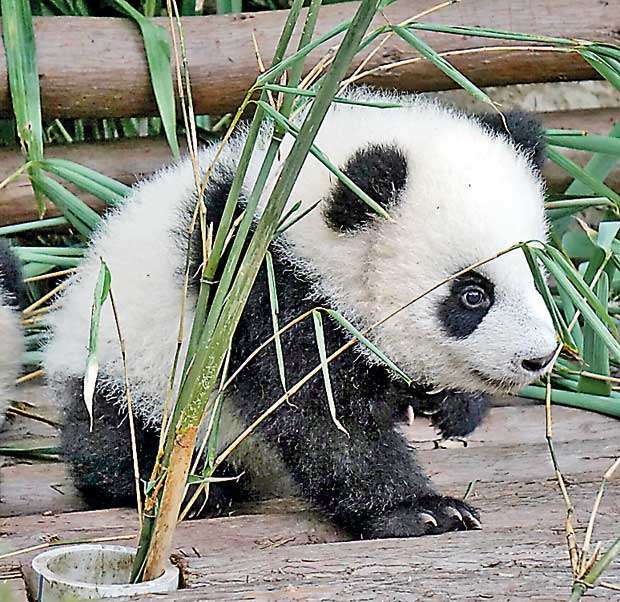Reply To:
Name - Reply Comment

 When one talks about China there is a beautiful animal with a peculiar colour combination of black and white which pops up in our minds; the panda. This animal has been one of main symbols of China in many ways than one. In one way they are a treasure for China in terms of tourism. Sometimes this adorable animal helps China to improve its international relations. There are more than 10 countries in the world who were gifted with pandas by the Chinese Government, mainly to improve relationships. So the panda is an important animal for China in many aspects.
When one talks about China there is a beautiful animal with a peculiar colour combination of black and white which pops up in our minds; the panda. This animal has been one of main symbols of China in many ways than one. In one way they are a treasure for China in terms of tourism. Sometimes this adorable animal helps China to improve its international relations. There are more than 10 countries in the world who were gifted with pandas by the Chinese Government, mainly to improve relationships. So the panda is an important animal for China in many aspects.
Although the panda is a key icon of the whole of China, currently this animal is living in only 3 provinces in this country. 80% of the pandas are living in the beautiful province of Sichuan situated in the South West of China. When China started its conservation programme in middle of the 20th Century there were less than 800 pandas in the wild. There was a huge workload to be done to stop this animal from extinction. There were huge challenges to overcome. Other than the human threat there were many natural problems stifling the panda conversation programme.
After the artificial insemination was founded the number of pandas was risen rapidly. They have made agreements with several world class organisations
Though panda is a carnivore animal 98 % of it’s daily diet consists of bamboo plants. Since the energy content of bamboo is really poor pandas have to eat more than 30 kg of bamboos to fulfill their daily energy needs. The bamboo coverage is diminishing and this is exposing the pandas to danger. Also Pandas are very lazy. They are not fast moving animals. Panda couples are even lazy to mate. This also contributes to the threats they face. According to scientists female pandas mate just 36 hours for the whole year. Panda mothers always give birth to two cubs, but she has the habit of feeding only the strongest cub. So in the wild one cub faces premature death. After considering all of these facts the Chinese authorities have decided to start conserving pandas through captive breeding.
China began captive breeding of pandas in 1955. The Chengdu Panda Research and breeding centre which was commenced in 1987 is a major part of this programme. It was founded with 6 pandas who survived the wild conditions. The number of pandas living in Chengdu Breeding Centre rose to130 in 2008.
Even during the early days, when they were attempting panda conversation, they had much issues with technology, but China’s rapid development in technology has given panda conversation a real boost.
Chengdu Panda Breeding Centre possesses the world’s top and latest scientific resources and the Chinese Government is investing large amounts of money to save this valuable animal. In the 1970s the rate of baby panda survival was just 30% and with these new resources it has increased up to 90%. This shows huge development. Currently the world largest collection of Artificially inseminated animal collection is available in this captive area for pandas.
This facility is located just 10km from China’s best commercial hub, Chengdu City Centre. The pandas at Chengdu Panda Breeding Centre offer huge value for tourism in Sichuan province. The panda base in Chengdu consists of 92 acres and that area consists 10,000 clumps of bamboos which form the diet and habitat for these animals. The breeding centre is planning to expand its area by another 500 acres so as to prepare the pandas to be released to the wild.
Chengdu Panda Breeding & Research Centre through its work has increased the survival rate of this much loved animal
The giant panda museum of Chengdu Panda Research Centre was found in 1993 to improve the public awareness of saving both panda animals and their environment. This is the world’s only Thematic museum for such a rare and endangered animal species. The museum consists of 10,000 samples of mainly pandas, but there are also samples and fossils of other animals like birds and insects which were collected in Sichuan Province.

After the artificial insemination was founded the number of pandas was risen rapidly. And to improve the research and technology of this base, they had made agreements with several world class organisations including East Bay Zoological Society California- USA, University of Liverpool, Nihon University Japan etc. The protection of baby pandas is and another huge task which is successfully being done at this base. Panda cubs when born are blind and hairless and their size is just 1/900 of their mothers. So these naturally weak cubs have a remote chance of living long in the wild. But within the panda base they are scientifically protected. Also inside this centre both cubs have the chance to live long. 10 years ago the panda base started offering lifeline to one of these cubs who was ignored by the mother. Now this weak one has become a strong male panda. The name Scientists have given him is “Miracle”.
The focus of the Chinese Government on animal conservation through Chengdu Panda Research and breeding is really huge. These are lessons to the world. When countries develop they lose their focus on animal conservation. But it is nice to see a country like china which is making fast development in technology and trade but not losing its focus on animal conservation.
Special Thanks to Dr. Junjie Wen and Pro. Shuang Xin
(The writer is attached to the Department of International Tourism management, Sichuan University)